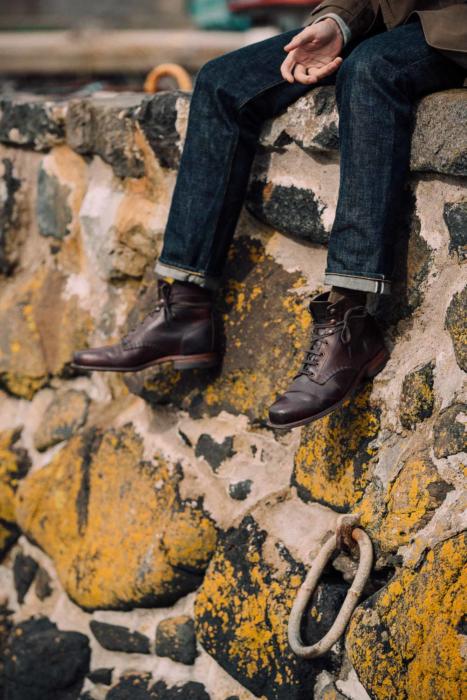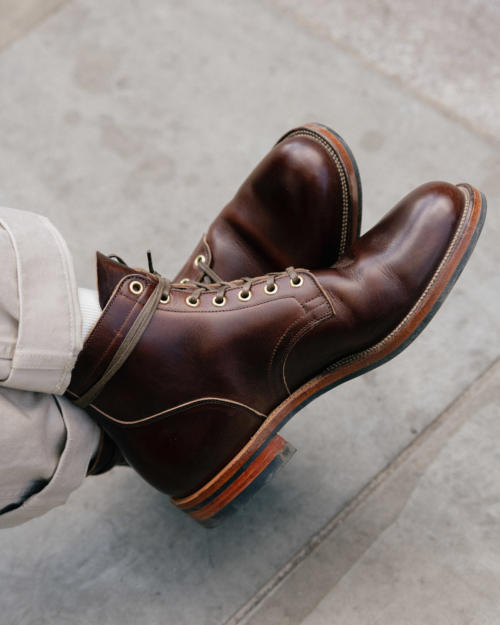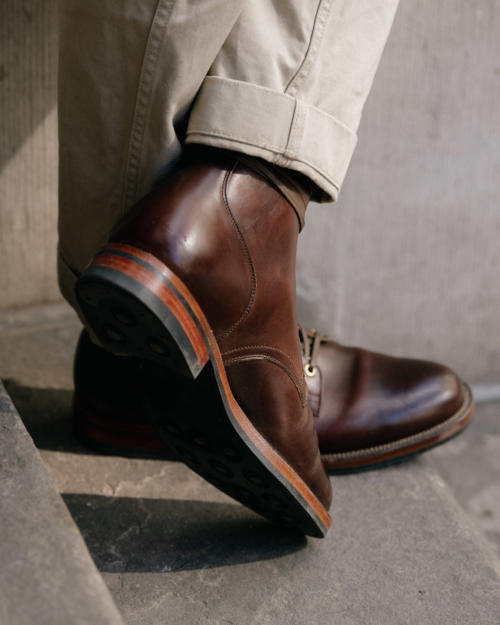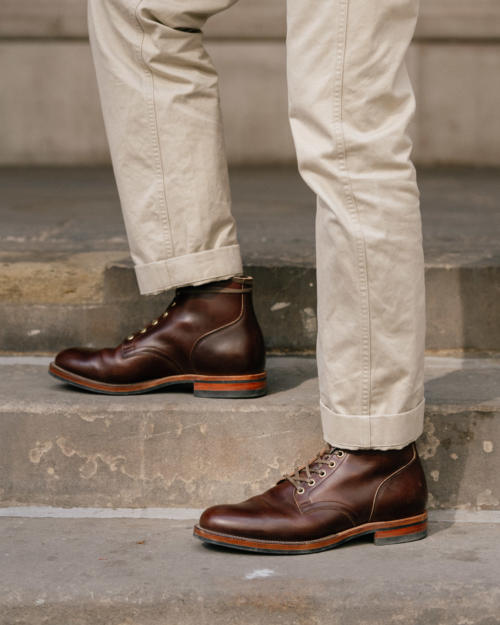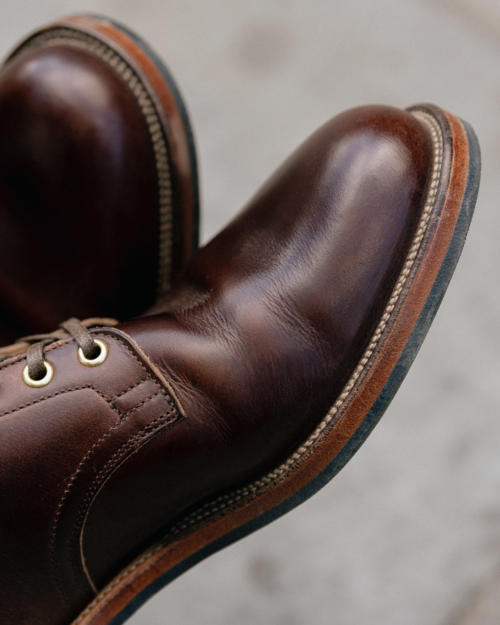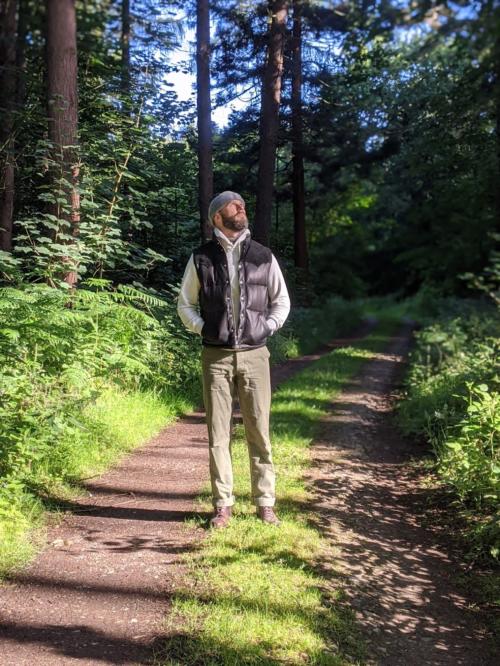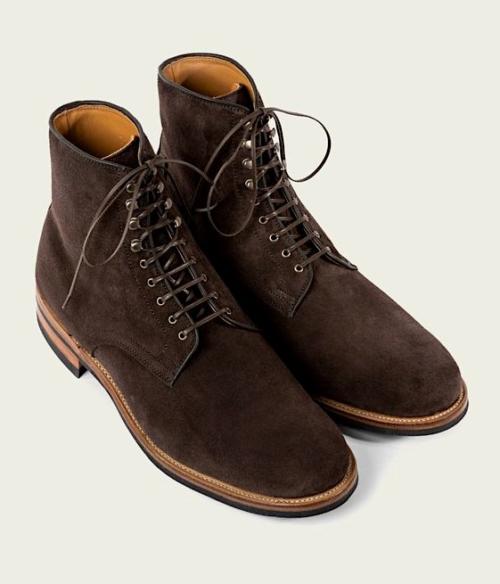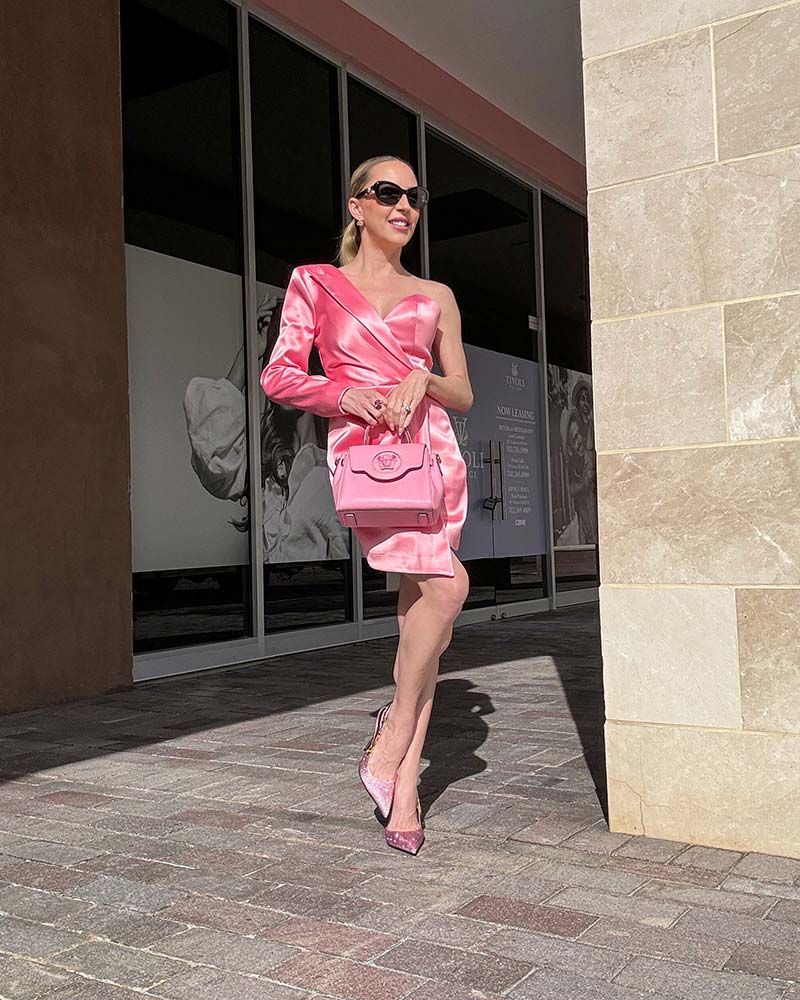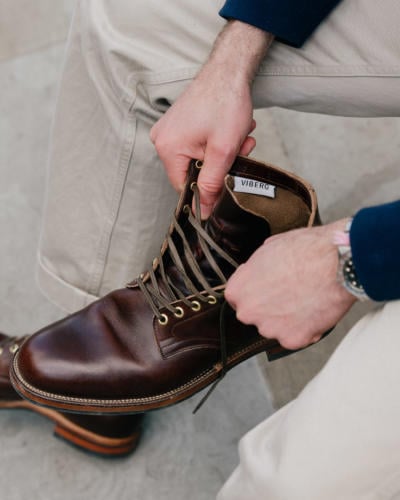
During the past Winter, I was vaguely looking to replace my longstanding work boots from Wolverine (above).
They’d done great service: on long country walks, camping in different parts of the country, and just going to the local park in rain, mud and snow.
But after 11 years the upper wasn’t in great shape, and the Wolverine make isn’t really on a par with the other shoes and boots I have. So I was looking to trade up.
It was an interesting journey, as it always is when you explore a new category of clothing (or indeed anything you enjoy) and I spoke to friends that were consumers, friends that were retailers, and a journalist or two.
I ended up settling on a pair of Viberg service boots (below) in a Horween brown Chromexcel. Seven eyelets, 2030 last, natural midsole, brown waxed laces and a stitchdown construction. As classic as it comes from Viberg.
In fact, a lot of what convinced me was the quality and approach of Viberg itself. So it’s probably worth explaining those, as well as giving some context of the work-boot category as a whole.
Not everyone likes the name ‘work boot’, but for a Permanent Style reader, I think it’s pretty apt.
Because what we’re talking about are boots that originated as equipment for proper heavy-duty work, and from companies that largely still make that kind of footwear.
This doesn’t really apply to any of the other brands we cover on PS. Someone like Tricker’s might be known for its boots, but they’re country footwear, not workwear. Harrison Ford might have built houses in Alden Indy boots, but the company is still arguably (and I expect argument here) a dress-shoe maker that also offers nice boots.
Work-boot companies like Red Wing, Whites or Wesco, on the other hand, made and make boots for logging, firefighting and ranching. Physical labour that requires a type of make.
What does this mean in practice? A chunky sole, certainly, but a thick midsole as well – sometimes a double one. Heavy, usually oiled uppers. Often a steel shank.
In terms of style it usually means a wider welt, a rounder toe, and sometimes white stitching or a natural mid-sole that separate the boot even further from the high-end makers we know.
The attraction to the lover of dress shoes is that these companies often still make along heritage lines, which means quality materials (eg full-grain leathers) and toughness through materials, rather than more steel or composites etc.
They’re boots that are still well made, but which you can camp in, climb in, and do similar outdoor activities.
Of course, the make depends a lot on the brand. And this is how I see the market (thanks to all those that provided information, experience and opinions here – and to readers that will doubtless chip in with their tuppence-worth now):
- Entry level is brands like Wolverine, Red Wing, Thorogood and perhaps Thursday boots. The latter is a newcomer, the others have history, but they’re all tough and very serviceable, with prices ranging around £200 to £300.
- The higher quality work boots come from the likes of White’s, Wesco and Nick’s Boots. These are a different quality level, pretty much indestructible, with double midsoles and huge leather footbeds. Prices rather higher, around £500 to £600.
- Viberg is more expensive still, around £700, and arguably out on its own. This is because they use finer materials (more calf, more Stead suede), and because there’s a more obvious push to offer more everyday, leisure styles. Which isn’t really what I was looking for, but more on that later.
Of course, the irony with comparing work-boot brands like this is that most of the time, fineness of make or materials doesn’t really matter.
The only thing the customer of a real work boot cares about is whether they’re comfortable to wear all day, protect the feet from everything, and last a really long time. It doesn’t matter if the sewing is a little wobbly.
The leisure customer might care more though – as well as caring about the style. Almost on the point of principle: they buy the best quality in everything else, so why should this be any different?
I won’t go into a lot of detail on Viberg, as that could be a whole post on its own (and it’s maybe an interesting one for those I know in Northampton, as much as consumers). But I’ll briefly explain why I liked the Service Boot.
Compared to a lot of work boots, it is made on a fairly slim last – the 2030, which owner Brett Viberg created in 2010 in the process of redefining the styles Viberg offered. (Brett is grandson of the Viberg founder.)
It also has a fairly low toe – not that far off the ground – which of course is called ‘spring’. Dress shoes vary in how much they have too, but it varies particularly in work boots, with some almost comically turned up (see the 310 boot).
Viberg boots had always been made with a fairly slim waist, in order to give greater support to the arch over hours of hard wear, and the combination of this with the new slim last created a Service Boot which it was much easier to wear outside work.
The result still looks very different to anything else we’d normally cover on PS. The toe box is still wider and higher. It’s a stitchdown construction, which you never get with dress shoes. And the Chromexcel leather of course starts looking oily and only gets more so, fading and creasing.
But as an option to wear outdoors, with the kind of chinos, sweatshirt and gilet sold by The Real McCoy’s and many others, it’s perfect.
The Viberg website is a little confusing, and personally I find the styles less appealing the further they get away from work boots – there are derbys, slippers and even trainers.
I did try a few other styles, including the chelsea boot and hiking boots, but only found the Halkett as another style I liked (below). It’s Goodyear-welted, and is a newer model aiming at a more urban customer.
The Halkett is nice, particularly in this ‘bitter chocolate’ grey/brown colour. But although welted, it still has the toe shape of a work boot to my eye. Which is not what I want from Viberg. I’m happy with my outdoorsy trade up.
Other clothes pictured:
Camping shot:
Photography: Alex Natt @adnatt

